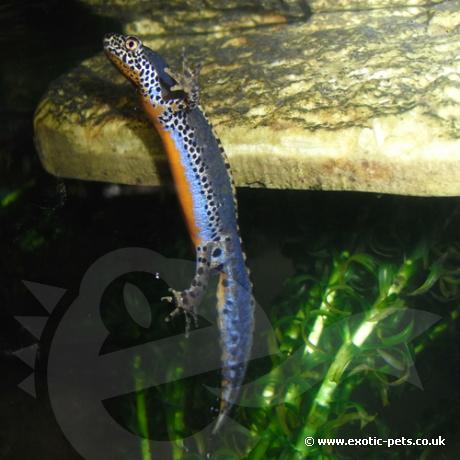

The Alpine Newt is one of the larger species within this family reaching a length of 10-12cm, males are smaller. Females are drab looking whereas males are brightly coloured during courtship.
| Origin | Europe and Russia |
|---|---|
| Environment | Pools and streams |
| Adult Size | Up to 12cm |
| Suitability | Novice keeper |
| Lifespan | Up to 15 years |
There are approximately ten subspecies of Alpine Newts with I.a.alpestris being the largest reaching an adult length of 10-12cm (4-5 inches). Females tend to have a grey/brown marbled look with a yellow to light orange belly with some spotting. Males in breeding conditions are noticeable different; they have an iridescent blue/grey marbled body with a deep orange coloured belly with no spotting present. A low yellow and black banned crest is also present starting from the neck running the length of the body. When not in courtship, the males crest disappears and the blue iridescent fades to a grey marbled colour; swelling around the cloaca is also reduced.
The Alpine newt was formerly placed within the genus Triturus, this has now been changed to Ichthyosaura alpestris alpestris.
The Alpine Newt is one of the widest spread subspecies; they range from Denmark, Northern Greece to Eastern Russia. They are always found close to water and can even be found living in stagnant water pools.
Depending on the amount of Alpine Newts being kept, we would recommend approximately six for a 3ft aquarium. Provide a half land, half water aquarium or at least a large floating land/dock area or a rocky area that protrudes out of the water. During courtship, they will spend more time in the water breeding and laying eggs; after this, you tend to find them on the land area. Water depth should be no less than 25cm (10 inches).
Being a European species, Alpine Newts prefer cooler temperatures of no more than 16C (61F). During the winter months and to stimulate breeding, water temperature should drop down to 2C (36F). No aquarium heater is required unless you are keeping these in a very cold room throughout the year; they do need to have a few months of slightly warmer temperatures. Use a low powered internal filter to maintain the water quality. Just like fish, we recommend doing a 25% water change weekly; you must use de-chlorinated or fresh rainwater when doing this.
UVB lighting is not essential unless you have live plants within your aquarium. One benefit for using UVB lighting; it will show the colours of your Alpine Newts, especially when breeding.
Smooth gravel or sand can be used on the bottom of the tank or some people prefer to keep this clear so they can see if there is any uneaten food that may need removing. Place rocks and plants within the aquarium sections and a few hides upon the land area.
Feeding is very easy with this species; feed on frozen/live bloodworm, Daphnia, chopped earthworms and small insects such as crickets. Dust the insects with a vitamin and mineral supplement once a week.
One important bit of information; you must ensure that you have a secure lid. Like most newts, they tend to walk up the glass or filter wire and squeeze through the tightest gaps, use sponge to fill in any holes.
Please note: These Newts are not native to the UK, they cannot be kept outdoors in ponds as they are classed as an invasive species. We will not accept orders to those who intend to keep them this way.